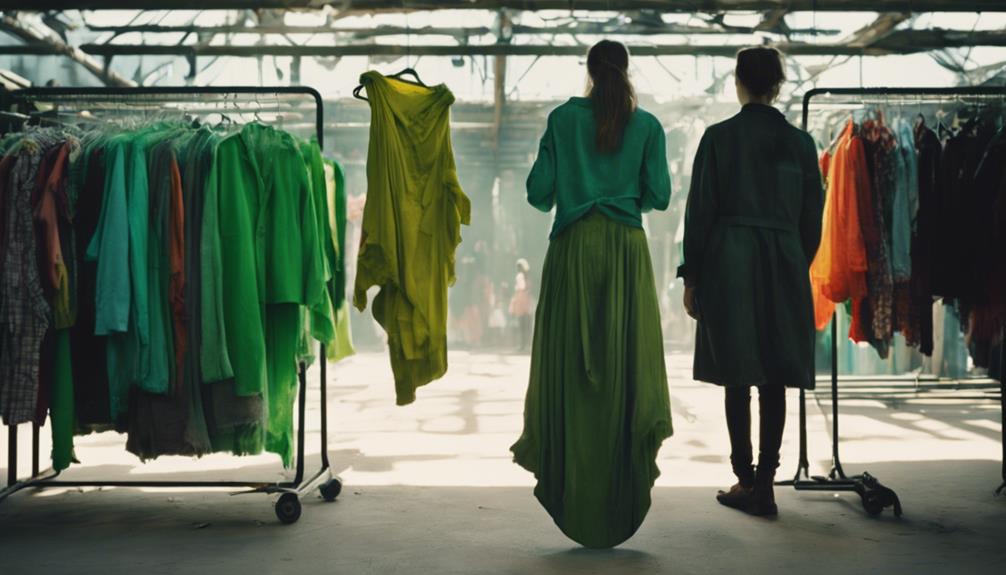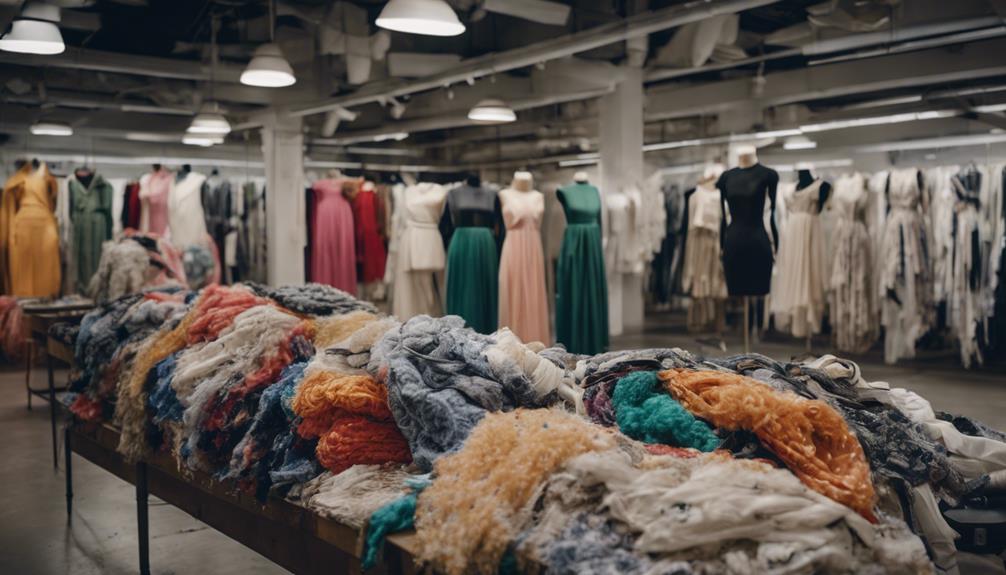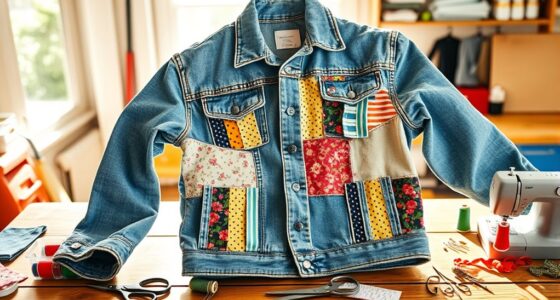Sustainable fast fashion merges fashionable designs with ethical manufacturing to combat environmental and social issues. It confronts the immense waste produced by the fashion industry, with 87% of clothing items ending up in landfills. By promoting sustainable materials, encouraging clothing exchanges, and advocating for secondhand shopping, it promotes a circular economy. However, it is essential to be wary of greenwashing; many brands deceive consumers with ambiguous claims. Your purchasing decisions can influence the demand for authentic sustainability practices. By making informed choices, you contribute to creating meaningful changes in the industry. Join us to discover more insights on navigating sustainable fashion wisely.
Key Takeaways
- Sustainable fast fashion merges trendy clothing with ethical production to tackle environmental and social challenges in the fashion industry.
- The industry produces around 100 billion garments annually, with 87% ending up in landfills, contributing significantly to waste and greenhouse gas emissions.
- Greenwashing misleads consumers, as approximately 39% of sustainability claims in fashion are potentially false or vague, complicating the identification of genuinely sustainable brands.
- Consumer choices play a crucial role; prioritizing quality and sustainable materials can significantly reduce textile waste and promote responsible production practices.
Understanding Sustainable Fast Fashion
Sustainable fast fashion combines trendy clothing with ethical production, aiming to tackle the environmental and social issues traditional fast fashion creates. You mightn't realize it, but the fashion industry produces about 100 billion garments each year, with a staggering 87% ending up in landfills. This alarming statistic highlights the urgent need for sustainable fashion solutions. Fast fashion's environmental cost is immense; it contributes around 4% of global greenhouse gas emissions, and without intervention, that could rise to 26% by 2050.
To combat this crisis, sustainable fast fashion advocates for eco-friendly materials and practices. You can take action by embracing practices like clothing swaps or shopping secondhand, which not only reduce waste but also promote a circular economy. By choosing sustainable options, you're helping to extend the life of garments and reduce the average wear of just 10 times per item.
Understanding sustainable fast fashion is crucial for making informed choices. By shifting your purchasing habits and supporting ethical brands, you can play an essential role in creating a more sustainable fashion industry that respects both people and the planet.
The Impact of Greenwashing

Greenwashing deceives consumers by masking harmful practices with misleading sustainability claims, creating confusion in the quest for truly ethical fashion. Approximately 39% of sustainability claims in the fashion industry are potentially false or misleading, leaving you unsure about what constitutes a sustainable brand.
Major fast fashion players like H&M and Zara have faced criticism for their vague greenwashing tactics, which often include unverified certifications and ambiguous terms like 'eco-friendly.' Despite the marketing buzz around recycled materials, only 3% of clothing is actually made from them, revealing a stark gap between claims and reality.
This prevalence of greenwashing not only undermines genuine sustainability efforts but also distorts your perception of what truly ethical fashion looks like. With confusing labels and terms, it becomes increasingly difficult to identify brands that are genuinely committed to sustainable practices.
As you navigate the world of fast fashion, remember that not all claims are created equal. Stay vigilant and question the authenticity of sustainability messages to guarantee you support brands that truly prioritize ethical production and environmental responsibility.
Consumer Responsibility and Choices

As you navigate your fashion choices, remember that your purchasing decisions can drive demand for more ethical practices in the industry. The shift towards fast fashion, with brands like SHEIN and Alibaba offering low prices, often overshadows consumer responsibility. By prioritizing cost over ethics, many contribute to a cycle that harms the environment and promotes waste.
You can combat this trend by choosing sustainable materials and focusing on quality over quantity. With 87% of garments produced ending up in landfills, your choices matter. Engaging in clothing swaps or buying secondhand can greatly reduce textile waste, as only 1% of discarded clothing is recycled.
Moreover, take the time to scrutinize brands for genuine sustainability efforts. Avoid those that make misleading eco-claims; this not only supports ethical practices but also encourages brands to adopt more responsible production methods.
Innovations and Their Limitations

Exploring innovations in sustainable materials reveals significant limitations that hinder real progress in the fashion industry. While you might see high-profile advancements like bio-based fabrics and recycling initiatives, these innovations haven't substantially reduced the environmental impact of fashion. The reality is that the industry's footprint has remained largely unchanged over the past 25 years.
Many business models, such as recycling, resale, rental, and reuse, often fall short of their sustainability claims. Most clothing produced is still made from non-biodegradable materials, eventually ending up in landfills. This misconception that sustainability exists on a spectrum can lead you to believe that 'less unsustainable' options are genuinely sustainable, but they often lack significant ecological benefits.
Despite your growing interest in sustainable practices, the effectiveness of current business models in tackling the root causes of environmental degradation is questionable. There's little alignment between consumer behavior and industry practices.
For real progress in sustainability, collaborative efforts across the fashion industry and a systemic change approach are essential. Isolated innovations simply aren't enough to create the meaningful change you want to see.
The Path Forward for Fashion

The path forward for fashion lies in embracing systemic change that prioritizes sustainability and ethical practices throughout the entire industry. You can support this movement by choosing brands that emphasize eco-friendly materials and ethical labor practices. When you make informed purchasing decisions, you help drive demand for responsible fashion, encouraging brands to adopt sustainable practices.
Collaborative efforts between brands, NGOs, and consumers are vital for achieving real sustainability goals. By participating in initiatives like clothing swaps, rental services, and repair programs, you can actively reduce textile waste and promote a circular economy. These innovative business models challenge the traditional fast fashion paradigm and offer practical alternatives for conscious consumers like you.
Advocacy for stronger regulatory frameworks is also essential. Supporting policies that hold fashion brands accountable for their environmental and social practices guarantees that sustainability becomes a standard requirement, not just a marketing strategy.
As you engage in these conversations and actions, you contribute to a more sustainable fashion industry that benefits everyone. Together, we can reshape the future of fashion, making it not only stylish but responsible and ethical.
Frequently Asked Questions
What Is the Dark Truth Behind Fast Fashion?
Fast fashion's dark truth includes its massive carbon footprint, wasteful practices, and exploitation of workers. You contribute to environmental harm and social injustice every time you choose cheap, disposable clothing over sustainable alternatives. What is sustainable fashion? Sustainable fashion is an approach to clothing production and consumption that prioritizes ethical and environmentally-friendly practices. This includes using organic and natural materials, reducing waste during the production process, and ensuring fair wages and working conditions for garment workers. By making thoughtful and informed choices about the clothing we buy, we can help reduce the negative impact of the fast fashion industry on the planet and its people.
What Is Sustainable Fast Fashion?
Sustainable fast fashion focuses on producing trendy clothing quickly while minimizing environmental harm. You'll find eco-friendly materials and fair labor practices, aiming to reduce waste and promote responsible consumption without completely abandoning fast fashion's appeal.
What Is the Problem With Sustainable Fashion?
Sustainable fashion's a double-edged sword; while it aims to reduce waste, the reality is stark. You'll find many brands making misleading claims, and only a tiny fraction of clothing gets recycled. It's frustrating, right?
What Is a Fact About Sustainable Fashion?
A key fact about sustainable fashion is that it aims to reduce waste by promoting the use of natural materials and encouraging you to choose quality over quantity, helping to lessen environmental impact considerably.
Conclusion
As you navigate the vibrant marketplace of fashion, remember that every choice you make is like planting a seed in the soil of sustainability.
You can nurture a garden of ethical practices or let weeds of greenwashing take root.
Embrace the innovations that thrive, but be mindful of their limitations.
By choosing wisely, you're not just dressing yourself; you're weaving a new narrative for the industry, one that honors the earth and its resources.
Your actions matter!









